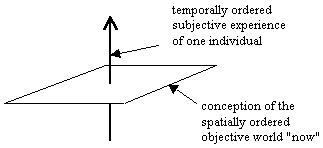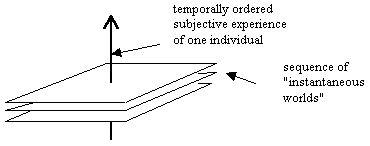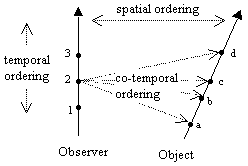There have been many theories of relativity throughout history, from Aristarchus to Einstein, each representing a profound re-interpretation of our experiences. However, most of the experiences themselves (at least on the level of raw sense impressions) have never changed. Instead, it was our conception of "the objective world", presumed to underlie and induce those experiences, that changed. This demonstrates that our direct sense impressions are (at least roughly) compatible with widely differing conceptions of the world. In view of this, philosophers have often suggested that the very idea of an "objective world" is misguided, and argued against constructing conceptual models of an external reality underlying an individual's immediate perceptions. As Berkeley put it, "esse est percipi" (to be is to be perceived).
Nevertheless, it is undeniable that physics has historically advanced largely through attempts to rationalize our observations, i.e., to reconcile our raw experiences with some rational and realistic conceptual framework in terms of an external objective world. Admittedly the brute facts of experiment have sometimes required adjustments to our sense of "realism", but it remains true that our prior sense of realism has always been one of the most significant factors guiding us and shaping our theories. Even in the field of quantum mechanics, which has been (at least arguably) the field of physics most resistant to complete realistic reconciliation, we still cannot dispense with what Bohr termed the "correspondence principle", according to which the observables of the theory must conform to the observables of our classical realistic models in the appropriate limits.
Naturally our interpretations of experience are always provisional, since they are necessarily based on an incomplete induction, but our conceptual models of an objective world have proven so heuristically useful that it would seem rash to abandon them entirely, even if we acknowledge that no particular conceptual model of the world is likely to be definitive and final. In any case, although the cumulative effect of the succession of re-interpretations wrought by relativity theories has undoubtedly contributed to the logical-positivist tendencies of some philosophers, the individual theories themselves (including Einstein's) have all been purely classical in the sense that they provide realistic models of an external objective world. They did not challenge the idea of an objective world. They merely asserted that the structure of that world was different than had previously been thought.
To appreciate how these changes in interpretation come about, we need to consider our actual experiences themselves, without prejudices or pre-conceived notions of the sort of external world that may be inducing them. This isn't easy, because our conventional notions of time and space are such integral parts of our thought processes, but it's necessary if we are to avoid imposing constraints on our world model that are not really implied by our observations. On the other hand, if we dispense with every preconceived notion, including ordinary rules of reasoning, then we can hardly hope to make any progress. Every axiomatic system contains some undefined elements, which must simply be accepted as working hypotheses. The range of possible axiom systems is limitless, and the ultimate test of any particular system is the usefulness of the resulting theory.
As a crude example of a moderately abstract representation of individual experience, suppose we define an idealized observer as a linearly ordered sequence of states Si, Si+1,..., each of which receives a packet of information M (memory) from the previous state, and a packet of information E (experience) from external sources, as illustrated below:

Each primitive experience Ej possesses a set of attributes Aj = A(Ej). Let us suppose that over some range of experiences Em to En the attribute sets form a space that is spanned by three variables, q(A), f(A), and a(A), so that two experiences Ei and Ej have identical attributes if and only if q(Ai) equals q(Aj), and so on (neglecting a finite number of singularities in the coordinates). Furthermore, suppose the values of these variables change only incrementally from one state to the next, with the understanding that the value 2p is identified with 0, and q is identified with p-q. On this basis the observer arrives at the conventional interpretation by which the experiences over this range of states correspond to fixed external objects arranged such that the variables q and f represent latitude and longitude of a spatial direction and a represents the spin angle about that direction. The (minimum) number of variables needed to span the space determines the dimensionality, and the fact that the variables change only incrementally from one state to the next suggests a continuous manifold.
The above describes roughly how an abstract observer might infer an orientation space within which the objects of experiences reside. The only motion contemplated in this model is rotation of the observer, collecting information from various directions and at various attitudes. It�s worth noting that this interpretation is necessarily conjectural on the part of the observer, and based on imperfect perceptions. There may be other, perhaps more complex, interpretations that correspond as well or better with the observer�s actual sequence of experiences. For example, the identification A(q,f,a) = A(q,f+2p,a) might be only approximately valid, and perfect equivalence might occur only for some multiple of 2p, or perhaps not at all. Also, the observer�s process of induction assumes a stratification of experiences so that the orientation effects can be distinguished from other kinds of changes. In particular, it is assumed that the mutual relations between the inferred external objects is not changing, at least over a sufficiently small range of states.
However, when considering larger ranges of states the observer begins to perceive deviations from the simple three-variable model, and finds it necessary to add three more variables x(A), y(A), and z(A) in order to span the space of experiential attributes. In conventional terms, these variables represent the spatial position of the observer relative to the inferred external objects. It remains true that the simple orientation model applies over sufficiently small ranges of states, so these translational variables are perceived to be orthogonal to the orientation variables. In other words, at any given "spatial location" (x,y,z) the observer experiences (or can experience) the same structural space of orientations, although the attribute sets that comprise the space may be new. Like the orientation variables, the translation variables change only incrementally from one state to the next, although there is no apparent periodicity. (On a more subtle level, the detailed metrical aspects of the x,y,z variables will also be found to differ from those of the q,f,a variables, but only after quantitative units of measure and coordinates have been established.)
The next stage in the development of our hypothetical observer is prompted by the detection of a more subtle and complicated variation in the experiential attributes of successive states. The observer notices that while most of the orientation space is consistent with a fixed position (x,y,z), some particular elements do not maintain their expected locations with respect to all the other elements, and no combination of changes in x,y,z or q,f,a can restore the expected arrangement. Previously the pattern of experiences had exhibited a coherence that enabled changes to be parameterized with just a few degrees of freedom, but now the inferred external objects can no longer be modeled (at least not easily) based on the premise that their relations with respect to each other are unchanging. So, having imagined a three-dimensional translational space in which the external objects were assumed to be statically arranged, the observer now concludes that, just as he himself can translate through the space, so also can individual external objects. Thus, to each object we now assign an independent set of x,y,z coordinates for each state of the observer.
In so doing we have introduced the notion that there are such things as "external objects", corresponding to the elements of our sensory inputs, and that their identities persist from one event to another. There are obviously many other possible interpretations. For example, we could imagine that one external entity simply ceased to exist, and another similar entity in a slightly different position has come into existence. According to this view, there is no motion at all, but simply a sequence of arrangements with some similarities. This may seem rather obtuse, but in fact according to the theory of quantum mechanics we cannot unambiguously map the identities of individual elementary particles (such as electrons) from one event to another. Thus the seemingly innocuous assumption of continuous identities for material objects through time is actually, on some level, demonstrably false. Without the ability to map the identities of individual objects from one event to another, what becomes of the idea of motion?
An equally important question is, if physical objects do not maintain definite identities through time, why does it seem that - at least for the macroscopic objects of our daily experience - they do maintain definite identities? This is one of the boundaries between the theories of relativity and quantum mechanics, which seem to be based on distinct and incompatible interpretative premises. For most of this book we will concentrate on the implications of the macroscopic view, i.e., the realm of relativity, but the clash with quantum mechanics is unavoidable, and we will return to it in the last section, after we've explored the theory and implications of relativistic physics, to reconsider the issue of compatibility with quantum mechanical phenomena.
For the moment, we will continue with our description of the origin or our ideas of space, time and motion, based on the premise that there do exist definite external objects, and that their identities persist through the sequence of events. Combining the rotational symmetries and the apparent translational possibilities that we infer from our primary sense impressions, we conventionally arrive at a conception of the external world that is, in some sense, the dual of our subjective experience. In other words, we interpret our subjective experience as a one-dimensional temporally-ordered sequence of events, whereas we conceive of "the objective world now" corresponding to a single perceived event as a three-dimensional expanse of space as illustrated below:

In this way we intuitively conceive of time and space as inherently perpendicular dimensions, but complications arise if we posit that each event along our subjective path resides in, and is an element of, an objective world. If the events along any path are discrete, then we might imagine a simple sequence of discrete "instantaneous worlds":

One difficulty with this arrangement is that it isn't clear how (or whether) these worlds interact with each other. If we regard each "instant" as a complete copy of the spatial universe, separate from every other instant, then there seems to be no definite way to identify an object in one world with "the same" object in another, particularly considering qualitatively identical objects such as electrons. If we have two electrons assigned the labels A and B in one instant of time, and if we find two electrons in the next instant of time, we have no certain way of deciding which of them was the "A" electron from the previous instant. (Even more fundamentally, we have no way of mapping the spatial locations of one instant to "the same" locations in any other instant.) This illustrates that the intuitive concept of motion is based on the assumption of persistent identities of objects from one instant to another.
As it happens, quantum mechanics entails just such an inability to definitely transfer the identity of particles from one instant to the next, and it can be argued that a sequence of discrete worlds is one possible context in which this might be understood. However, in the macroscopic realm it seems that we can organize our experiences in terms of individual objects with persistent and unambiguous identities over time. This may lead us to suspect that the sequence of existence of an individual or object in any one instant must be, in some sense, contiguous with its existence in neighboring instants, and if these objects are the constituents of "the world", this suggests that space itself at any "instant" is continuous with the spaces of neighboring instants. This is important because it implies a definite connectivity between neighboring world-spaces, and this, as we'll see, places a crucial constraint on the relativity of motion.
Another complication concerns the relative orderings of world-instants along different paths. Our schematic above presupposed that the "instantaneous worlds" are well-ordered in the sense that they are encountered in the same order along every individual's path, but of course this need not be the case. For example, we could equally well imagine an arrangement in which the "instantaneous worlds" are skewed, so that different individuals encounter them in different orders, as illustrated below.

The concept of motion assumes the world can be analyzed in two different ways, first as the union of a set of mutually exclusive "events", and second as a set of "objects" each of which participates in an ordered sequence of events. In addition to this ordering of events encountered by each individual object, we must also assume both a co-lateral ordering of the events associated with different objects, and a transverse ordering of events from one object to another. These three kinds of orderings are illustrated schematically below.

This diagram suggests that the idea of motion is actually quite complex, even on this simple abstract level. Intuitively we regard motion as something like the derivative of the spatial "position" with respect to "time", but we can't even unambiguously define the distance between two worldlines, because it depends on how we correlate the temporal ordering along one line to the temporal ordering along the other. Essentially our concept of motion is overly ambitious, because we want it to express the spatial distance from the observer to the object for each event along the observer's worldline, but the intervals from one worldline to another are necessarily not confined to the worldlines themselves, so we have no definite way of assigning those intervals to events along our worldline. The best we can do is correlate all the intervals from a particular point on the observer's worldline to the object's worldline.
When we considered everything though the "eyes" of just a single observer this was not an issue, since only one parameterization was needed to map the experiences of that observer, interpreted solipsistically. Any convenient parameterization was suitable. When we consider multiple observers and objects we can still allow each observer to map his experiences using the most convenient system of coordinates (which will presumably include his own state-index as the temporal coordinate), but now the question arises as to how all these private coordinate systems relate to each other. To answer this question we need to formalize our parameterizations into systems of coordinates, and then consider how the coordinates of any given event with respect to one system relate to the coordinates of the same event with respect to another system.